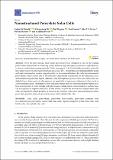Nanostructured perovskite solar cells
Abstract
Over the past decade, lead halide perovskites have emerged as one of the leading photovoltaic materials due to their long carrier lifetimes, high absorption coefficients, high tolerance to defects, and facile processing methods. With a bandgap of ~1.6 eV, lead halide perovskite solar cells have achieved power conversion efficiencies in excess of 25%. Despite this, poor material stability along with lead contamination remains a significant barrier to commercialization. Recently, low-dimensional perovskites, where at least one of the structural dimensions is measured on the nanoscale, have demonstrated significantly higher stabilities, and although their power conversion efficiencies are slightly lower, these materials also open up the possibility of quantum-confinement effects such as carrier multiplication. Furthermore, both bulk perovskites and low-dimensional perovskites have been demonstrated to form hybrids with silicon nanocrystals, where numerous device architectures can be exploited to improve efficiency. In this review, we provide an overview of perovskite solar cells, and report the current progress in nanoscale perovskites, such as low- dimensional perovskites, perovskite quantum dots, and perovskite-nanocrystal hybrid solar cells.
Citation
McDonald , C , Ni , C , Maguire , P , Connor , P , Irvine , J T S , Mariotti , D & Svrcek , V 2019 , ' Nanostructured perovskite solar cells ' , Nanomaterials , vol. 9 , no. 10 , 1481 . https://doi.org/10.3390/nano9101481
Publication
Nanomaterials
Status
Peer reviewed
ISSN
2079-4991Type
Journal item
Description
Funding: UK EPSRC EP/K022237/1, EP/M024938/1 and EP/R023638/1.Collections
Items in the St Andrews Research Repository are protected by copyright, with all rights reserved, unless otherwise indicated.
Related items
Showing items related by title, author, creator and subject.
-
Probing the energy levels of perovskite solar cells via Kelvin probe and UV ambient pressure photoemission spectroscopy
Harwell, Jonathon Robert; Baikie, T. K.; Baikie, I. D.; Payne, Julia Louise; Ni, Chengsheng; Irvine, John Thomas Sirr; Turnbull, Graham A.; Samuel, Ifor David William (2016-08-07) - Journal articleThe field of organo-lead halide perovskite solar cells has been rapidly growing since their discovery in 2009. State of the art devices are now achieving efficiencies comparable to much older technologies like silicon, ... -
Solution-processable perylene diimide-based electron transport materials as non-fullerene alternatives for inverted perovskite solar cells
Soto Perez, German; Dasgupta, Shyantan; Żuraw, Wiktor; Pineda, Rosinda Fuentes; Wojciechowski, Konrad; Jagadamma, Lethy Krishnan; Samuel, Ifor; Robertson, Neil (2022-04-22) - Journal articlePerylene diimide derivatives with different functional groups (OR) in the bay position were synthesised (PDI-1, OR = OC6H4OMe; PDI-2, OR = OC6H4CH2CH2NHBoc; PDI-3, OR = OC6H4CO2Me) and their optoelectronical properties ... -
A BODIPY small molecule as hole transporting material for efficient perovskite solar cells
Dos Santos, John Marques; Jagadamma, Lethy Krishnan; Cariello, Michele; Samuel, Ifor D. W.; Cooke, Graeme (2022-08-30) - Journal articleBODIPY-based materials are well known for their outstanding chemical and photo-stability as well as their ease of synthesis and tunability of their frontier molecular orbitals. These are attractive features for hole ...

